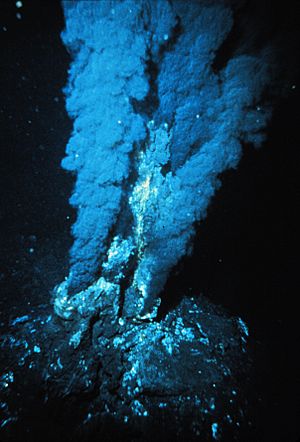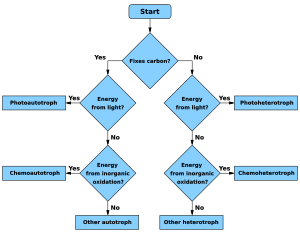Chemoautotroph facts for kids
A chemoautotroph is a special kind of living thing that makes its own food. Instead of using sunlight for energy, like plants do, it uses energy from chemicals! These chemicals are usually found in rocks, water, or gases.
After getting energy from chemicals, chemoautotrophs build their own food, which are called organic compounds. They use a special energy molecule called ATP to do this.
Most chemoautotrophs are tiny organisms like bacteria or archaea. You often find them in very unusual and tough places. Think of deep-sea vents, hot springs, or even deep underground! In these places, there's no sunlight, so chemoautotrophs are super important. They are the "primary producers," meaning they start the food chain for other creatures living there.
Contents
What is a Chemoautotroph?
A chemoautotroph is an organism that creates its own food. It does this by using energy from chemical reactions. The word "chemo" means chemical, and "auto" means self, while "troph" means nourishment. So, it literally means "self-nourishing using chemicals."
How They Make Food
Chemoautotrophs take simple inorganic chemicals from their environment. These chemicals don't come from living things. They then use these chemicals in a special process to get energy. This energy helps them turn carbon dioxide into organic compounds. Organic compounds are the building blocks of life. They are like the sugars, fats, and proteins that make up living things.
Energy from Chemicals
Imagine a tiny power plant inside these organisms. Instead of burning coal or gas, they "burn" chemicals like hydrogen sulfide, ammonia, or iron. This chemical reaction releases energy. This energy is then stored in ATP molecules. ATP is like the energy currency of the cell. It powers all the cell's activities, including making food.
Where Do Chemoautotrophs Live?
Chemoautotrophs love extreme environments. These are places where most other life forms can't survive.
Deep-Sea Vents
One famous place is around hydrothermal vents in the deep ocean. These are cracks in the seafloor that spew out super-hot, mineral-rich water. This water contains chemicals like hydrogen sulfide. Chemoautotrophs thrive here. They form the base of an amazing food web. Many unique creatures, like giant tube worms and strange crabs, depend on these chemoautotrophs for food.
Other Extreme Places
You can also find chemoautotrophs in other harsh spots:
- Hot springs: Places like Yellowstone National Park have very hot, acidic water.
- Cold places: Some live under glaciers or in very cold ocean waters.
- Deep underground: They can be found in rocks and soil far below the surface.
- Polluted areas: Certain types help clean up pollution by breaking down harmful chemicals.
Why Are They Important?
Chemoautotrophs play a vital role in many ecosystems. Especially in places where there is no sunlight.
Starting the Food Chain
In deep-sea vents and other dark environments, chemoautotrophs are the "primary producers." This means they are the first step in the food chain. They create organic matter from inorganic chemicals. Without them, there would be no food for other organisms. It's like plants being the primary producers on land.
Recycling Nutrients
Chemoautotrophs also help recycle important chemicals on Earth. They convert chemicals like nitrogen and sulfur into forms that other living things can use. This process is called biogeochemical cycles. It keeps our planet's systems working.
Flowchart
This flowchart helps you understand how different organisms get their food.
Related pages
Images for kids




